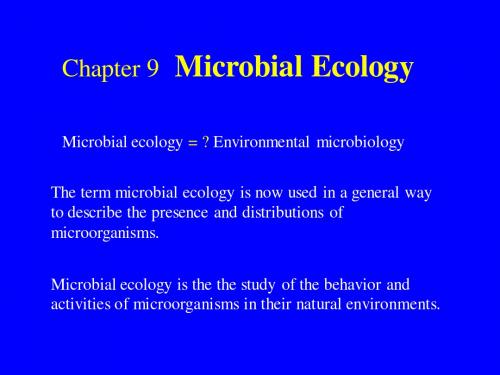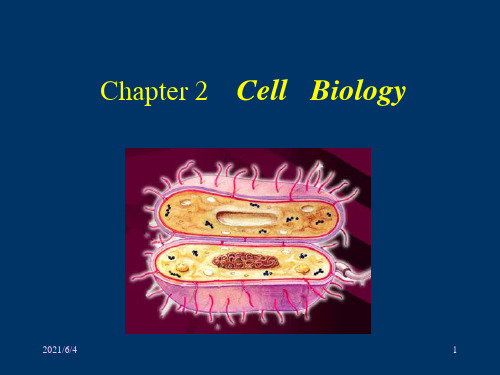华中农业大学微生物英文版课件9
合集下载
微生物生长 华中农业大学微生物学课件

3、薄膜过滤计数法
用于计 数空气 或水中 的含菌
数
菌数低样品(如水)→膜过滤→培养→菌落计数
(二)细胞生物量的测定
n 测定细胞干重法
单位体积培养物中细胞物质的干重
n 含氮量测定法
微生物细胞中蛋白质的含量是比较稳定的,测出微生物 细胞中的含N量后再换算出蛋白质的含量,可用凯氏定 N法 。
蛋白质的含量=氮量×6.25
2. 利用选择性培养基分离
微生物群落中数量占少数的微生物的分离纯化
t 抑制大多数其它微生物的生长
t 使待分离的微生物生长更快
使待分离的微生物在群落中的数量 上升,方便用稀释法对其进行纯化。
根据所要分离的菌种特性选用培养基,如:
不同菌对营养的要求
分离真菌,用马丁氏培养基,pH偏酸 分离放线菌,用高氏1号,pH中性偏碱
Chapter 6 第六章 微生物的生长与环境条件
n 第一节 微生物生长量的测定 n 第二节 细菌群体的生长 n 第三节 环境条件对微生物生长和代谢的影响
第一节 微生物生长量的测定
一. 获得纯培养的方法 二. 细菌群体生长的测定
一、获得纯培养的方法
q 微生物在自然界总是混杂地生活,要 想研究某一种微生物,必须把研究对象 从混杂群体中分离出来。
2、最大概率法 (MPN 法)
§ 将待测菌液作十倍系列稀释,每稀释度3—5个重复,培养后 检查细菌的生长,以有细菌生长的最后三个稀释度的管数作数 量指标,由数理统计表查出近似值,再乘以数量指标第一位的 稀释倍数,即为原菌液的菌数。
例如:某细菌在稀释培养法中生长情况如下:
稀释度:
10—3,10—4,10—5,10—6,10—7,10—8
§ 稀释分离
华中农业微生物学第一章英文版

• The development of microbiology as a scientific discipline has depended on the availability of the microscope and the ability to isolate and grow pure cultures of microorganisms.
of microbiology
Concepts
• Microorganisms are responsible for many of the changes observed in organic and inorganic matter (e.g., fermentation and the carbon, nitrogen and sulfur cycles that occurred in nature.
The first person to accurately observe and describe microorganisms
The first person to observe and describe microorganisms was the amateur microscopist Antony van leeuwenhoek of Delft, Holland.
lens
Object being viewed
adjusting screws
A drawing of one of the microscopes showing the lens a; mounting pin b; and focusing screws c and d.
• Microbiology is a large discipline, which has a great impact on other areas of biology and general human welfare
of microbiology
Concepts
• Microorganisms are responsible for many of the changes observed in organic and inorganic matter (e.g., fermentation and the carbon, nitrogen and sulfur cycles that occurred in nature.
The first person to accurately observe and describe microorganisms
The first person to observe and describe microorganisms was the amateur microscopist Antony van leeuwenhoek of Delft, Holland.
lens
Object being viewed
adjusting screws
A drawing of one of the microscopes showing the lens a; mounting pin b; and focusing screws c and d.
• Microbiology is a large discipline, which has a great impact on other areas of biology and general human welfare
华中农业大学微生物英文版课件9

Rhizosphere Effect ( R/S ratio )
The rhizosphere is the soil region in close contact with plant roots.
Within the rhizosphere, the plant roots exert a direct influence on the soil bacteria. This influence is known as the rhizosphere effect.
Community 3
Microbial communities then interact with communities of macroorganisms to define the entire ecosystem.
The distribution of microorganisms in nature ecosystem depends on the resources (nutrients) available and on the growth conditions. Temperature, pH, water availability, light, oxygen of a habitat define the niche for each particular microorganism.
9.1.2. Terrestrial Environments
Proportion of different soil microorganisms in soil
Microbial number and biomass in cultivated field soil(15 cm)
Microbes Bacteria Fungi
华中农业大学微生物学第二章PPT课件

Chapter 2 Cell Biology
2021/6/4
1
Chapter Outline
2.1 Overview of the structure of microbial cells 2.2 Procaryotic cell wall 2.3 Cytoplasmic membrane 2.4 Cellular genetic information 2.5 Cytoplasmic matrix – Ribosome and Inclusions 2.6 Components external to the cell wall 2.7 Bacterial endospores 2.8 Comparison of the prokaryotic and eukaryotic cell
2. Their DNA is not associated with histidine
3. Their cell wall almost always contain the complex polysaccharide peptidoglycan
4. They are very small!!
A cyanobacterium 8 x 50 um
A rod-shaped prokaryote is typically about 1-5 micrometers (μm) long and about 1 μm wide
Microorganisms in general are very small and are completely invisible to the naked eye.
A eucaryotic cell
2021/6/4
4
The Prokaryotic Cell
2021/6/4
1
Chapter Outline
2.1 Overview of the structure of microbial cells 2.2 Procaryotic cell wall 2.3 Cytoplasmic membrane 2.4 Cellular genetic information 2.5 Cytoplasmic matrix – Ribosome and Inclusions 2.6 Components external to the cell wall 2.7 Bacterial endospores 2.8 Comparison of the prokaryotic and eukaryotic cell
2. Their DNA is not associated with histidine
3. Their cell wall almost always contain the complex polysaccharide peptidoglycan
4. They are very small!!
A cyanobacterium 8 x 50 um
A rod-shaped prokaryote is typically about 1-5 micrometers (μm) long and about 1 μm wide
Microorganisms in general are very small and are completely invisible to the naked eye.
A eucaryotic cell
2021/6/4
4
The Prokaryotic Cell
华中农业大学微生物英文版课件

Huazhong Agricultural University Microbiology Engl
目录
CONTENTS
• Introduction • Types of Microorganisms • Microbial Metabolism • Microbial Life Processes • Microbial Ecology • Microbial Pathogenesis and Disease
04 Microbial Life Processes
Cell Structure and Function
Cell membrane
Composition, function, and transport processes across the membrane
Cell wall
Structure, function, and role in maintaining cell shape and protecting the cell
Fungi play important roles in composition, nutrient cycling, and symbolic relationships with plants and animals
Some fungi are editable and have culinary uses, while others can cause diseases in plants and animals
Cultivation and Respiration
Microorganisms can be cultured in different environments, such as on solid surfaces or in liquid media The choice of cultivation environment depends on the type of microbiology and the desired outcome of the experience or study
目录
CONTENTS
• Introduction • Types of Microorganisms • Microbial Metabolism • Microbial Life Processes • Microbial Ecology • Microbial Pathogenesis and Disease
04 Microbial Life Processes
Cell Structure and Function
Cell membrane
Composition, function, and transport processes across the membrane
Cell wall
Structure, function, and role in maintaining cell shape and protecting the cell
Fungi play important roles in composition, nutrient cycling, and symbolic relationships with plants and animals
Some fungi are editable and have culinary uses, while others can cause diseases in plants and animals
Cultivation and Respiration
Microorganisms can be cultured in different environments, such as on solid surfaces or in liquid media The choice of cultivation environment depends on the type of microbiology and the desired outcome of the experience or study
华中农业大学微生物英文

extracellular and intracellular
Virion, the extracellular phase, posses Байду номын сангаасew if any enzymes and can not reproduce independently of living cells. In the intracellular phase, viruses exist primarily as replicating nucleic acids that induce host metabolism to synthesize virion components; eventually complete virus particles or virions are released.
Size
Viruses vary considerably in size. Although most are quite a bit smaller than bacteria, some of the larger viruses (such as the smallpox virus) are about the same size as some very small bacteria (such as the mycoplasmas, rickettsias, and chlamydias).
Chapter 5 Viruses
Chapter outline
5.1 General Properties of Viruses 5.2 General Features of Virus Reproduction 5.3 Overview of Bacterial Viruses 5.4 Temperate Bacteriophages: Lysogeny and Lambda 5.5 Overview of Animal Viruses 5.6 Pox Viruses 5.7 Adcnoviruses 5.8 Retroviruses 5.9 Viroids and Prions
Virion, the extracellular phase, posses Байду номын сангаасew if any enzymes and can not reproduce independently of living cells. In the intracellular phase, viruses exist primarily as replicating nucleic acids that induce host metabolism to synthesize virion components; eventually complete virus particles or virions are released.
Size
Viruses vary considerably in size. Although most are quite a bit smaller than bacteria, some of the larger viruses (such as the smallpox virus) are about the same size as some very small bacteria (such as the mycoplasmas, rickettsias, and chlamydias).
Chapter 5 Viruses
Chapter outline
5.1 General Properties of Viruses 5.2 General Features of Virus Reproduction 5.3 Overview of Bacterial Viruses 5.4 Temperate Bacteriophages: Lysogeny and Lambda 5.5 Overview of Animal Viruses 5.6 Pox Viruses 5.7 Adcnoviruses 5.8 Retroviruses 5.9 Viroids and Prions
华中农业微生物学第一英文 ppt课件
Our world is populated by invisible creatures too small to be seen with the unaided eye. These life forms, the microbes or microorganisms, may be seen only by magnifying their image with a microscope.
• The development of microbiology as a scientific discipline has depended on the availability of the microscope and the ability to isolate and grow pure cultures of microorganisms.
Chapter 1
Microorganisms and Microbiology
Chapter outline
1.1 What is a microbe? 1.2 The importance of Microbiology 1.3 Microbes in our lives 1.4 The history of microbiology 1.5 Important events in the development
The size and cell type of microbes
Microbe Approximate range of sizes
Viruses
0.01-0.25µm
Bacteria
0.1-10µm
Fungi
2µm->1m
Protozoa
2-1000µm
华中农业大学微生物学
Gram-positive Cell Wall
The Gram-positive cell wall has a peptidoglycan layer that is relatively thick (ca. 40 nm) and comprises approximately 90% of the cell wall. The cell walls of most Gram-positive eubacteria also have teichoic acids.
Naked eye
Eukaryotes
Light microscope
Electron microscope
Prokaryotes Viruses
Surface area and volume relationships in cells
a cell increases in size, its surface area – to – volume ratio decreases
Chemical Structure of Lipopolysaccharide
O side chain
Core polysaccharide
Lipid A
Molecular Model of E.coli Lipopolysaccharide
Cell Walls of Archaebacteria
The Prokaryotic Cell
1. Their genetic material (DNA) is not enclosed within a membrane and they lack other membrane – bounded organelles
(优选)华中农业微生物学第一章英文版ppt讲解
• The development of microbiology as a scientific discipline has depended on the availability of the microscope and the ability to isolate and grow pure cultures of microorganisms.
Our world is populated by invisible creatures too small to be seen with the unaided eye. These life forms, the microbes or microorganisms, may be seen only by magnifying their image with a microscope.
of microbiology
Concepts
• Microorganisms are responsible for many of the changes observed in organic and inorganic matter (e.g., fermentation and the carbon, nitrogen and sulfur cycles that occurred in nature.
Fungi (unicellular or multicellular)
Protozoa (unicellular)
Other (multicellular organisms)
The size and cell type of microbes
Most of the bacteria, protozoa, and fungi are single-celled microorganisms, and even the multicelled microbes do not have a great range of cell types. Viruses are not even cells, just genetic material surrounded by a protein coat and incapable of independent existence.
Our world is populated by invisible creatures too small to be seen with the unaided eye. These life forms, the microbes or microorganisms, may be seen only by magnifying their image with a microscope.
of microbiology
Concepts
• Microorganisms are responsible for many of the changes observed in organic and inorganic matter (e.g., fermentation and the carbon, nitrogen and sulfur cycles that occurred in nature.
Fungi (unicellular or multicellular)
Protozoa (unicellular)
Other (multicellular organisms)
The size and cell type of microbes
Most of the bacteria, protozoa, and fungi are single-celled microorganisms, and even the multicelled microbes do not have a great range of cell types. Viruses are not even cells, just genetic material surrounded by a protein coat and incapable of independent existence.
微生物英文课件-eucaryotes
• Rough endoplasmic reticulum (RER)– originates from the outer membrane of the nuclear envelop & extends in a continuous network through cytoplasm; rough due to ribosomes, proteins are synthesized & shunted into the ER for packaging & transport. First step in secretory pathway.
)
4.2.4. The cell membrane
- typical bilayer of phospholipids and proteins
- Sterols (固醇) confer stability - serve as selectively permeable barriers in transport; involved in cell-cell recognition, endo- and exocytosis and adhesion to surface; transport system is located in membrane
-Eukaryotic cells also contain membrane-bound organelles that account for 60-80% of their volume
•The most obvious difference between Eukaryotic cells and procaryotic cells is in their use of membranes.
- 1、下载文档前请自行甄别文档内容的完整性,平台不提供额外的编辑、内容补充、找答案等附加服务。
- 2、"仅部分预览"的文档,不可在线预览部分如存在完整性等问题,可反馈申请退款(可完整预览的文档不适用该条件!)。
- 3、如文档侵犯您的权益,请联系客服反馈,我们会尽快为您处理(人工客服工作时间:9:00-18:30)。
9.1 Microorganisms in nature ecosystem
1. Microorganisms and microenvironment 2. Terrestrial Environments 3. Freshwater Environments 4. Marine Environments
Metabolically related populations constitute groupings called guilds.
Sets of guilds conducting complementary physiological processes interact to form microbial communities.
9.2 Microbial population interactions
1, neutralism (中性关系 ) 2, commensalism (偏利关系 ) 3, synergism (协同关系 ) 4, mutualism (互惠关系 ) 5, competition (竞争关系 ) 6, antagonism (拮 抗关系 ) 7, parasitism (寄生关系 ) 8, predation (捕食关系 )
Numbers / g
Biomass (g / m3)
Bacteria
108
160
Fungi
105
200
Actinomycetes
105 - 106
160
Algae
104 - 105
32
Protozoa
104
38
Main types of soil microorganisms
Agrobacterium Arthrobacter Caulobacter Clostridium Flavobacterium Mycobacterium Staphylcoccus
Microbial populations in the rhizosphere may benefit the plant by:
(1) removing hydrogen sulfide, which is toxic to the plant roots
(2) increasing solubilization of mineral nutrients needed by the plant for growth
Community 3
Microbial communities then interact with communities of macroorganisms to define the entire ecosystem.
The distribution of microorganisms in nature ecosystem depends on the resources (nutrients) available and on the growth conditions.
Within the rhizosphere, the plant roots exert a direct influence on the soil bacteria. This influence is known as the rhizosphere effect.
In the rhizosphere, microbial populations reach much higher densities in the rhizosphere than in the free soil.
Carbon cycle
Carbon cycle
Carbon dioxide is incorporated, or fixed, into organic compounds by such photoautotrophs as cyanobacteria, green plants, algae, and green and purple sulfur bacteria.
Parasitism, the parasite population is benefited and the host population is harmed.
Predation is a widespread phenomenon where the predator engulfs or attacks the prey. The prey can be larger or smaller than the prey, and this normal results in the death of the prey.
9.1.2. Terrestrial Environments
Proportion of different soil microorganisms in soil
Microbial number and biomass in cultivated field soil(15 cm)
Microbes
Competition occurs when two populations are striving for the same resource of nutrients or the habitat.
Antagonism occurs when one population produces a substrate inhibitory to another population.
Competition
-
-
Amensalism
0 or +
-
Parasitism
+
-
Predation
+
-
0, No effect; +, positive effect; -, negative effect.
9.3 Biogeochemical cycles
1. Carbon cycle 2. Nitrogen cycle 3. Sulfur cycle 4. Iron cycle
Classification of population interaction
EFFECT OF INTERACTION
NAME OF
POPULATION
POPULATION
INTERACTION
A
B
Neutralism
0
0
Commensa#43;
+
Mutualism
+
+
Alcaligenes Bacillus Cellulomonas Corynebacterium Micrococcus Pseudomonas
Rhizosphere Effect ( R/S ratio )
The rhizosphere is the soil region in close contact with plant roots.
A soil aggregate composed of mineral and organic components, showing that localization of soil microbes. Very few microorganisms are found free in the soil solution; most of them occur as microcolonies attached to the soil particles.
Synergism indicates that both populations benefit from the relationship but the association is not obligatory. Both populations are capable of surviving independently.
Microbial ecology is the the study of the behavior and activities of microorganisms in their natural environments.
Environmental microbiology, in comparison, relates primarily to all- over microbial processes that occur in a soil, water or food, as examples. It is not concerned with the particular microenvironment where the microorganisms actually are functioning, but with the broader-scale effects of microbial presence and activities.
9.1.1 Microorganisms and microenvironment
populations guilds communities ecosystem
In a microbial ecosystem individual cells grow to form populations.
Temperature, pH, water availability, light, oxygen of a habitat define the niche for each particular microorganism.
Soil particles are not homogeneous in terms of their oxygen content. The outer zones of a small soil particle may be fully oxic, whereas the center, only a very short distance away, can remain completely anoxic.
